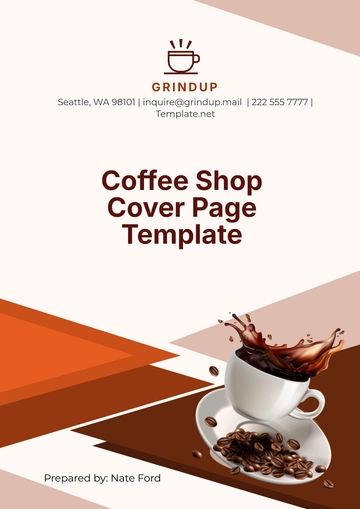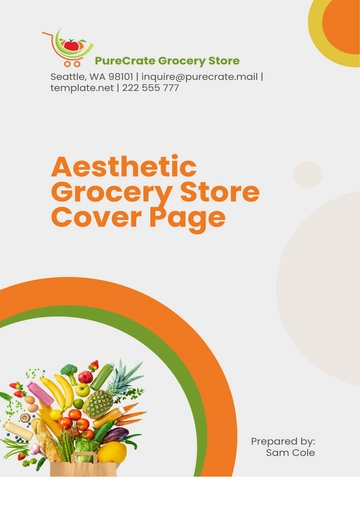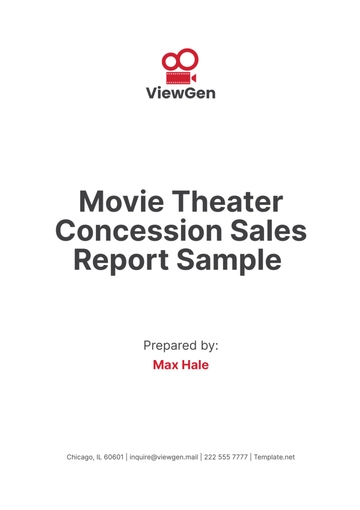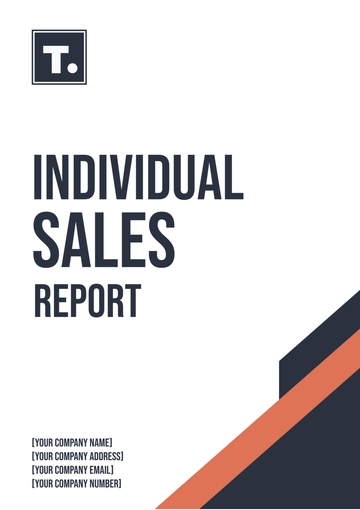Free Movie Theater Concession Sales Report Sample??Template

I. Executive Summary
A. Overview of Sales Performance
The sales performance of [Your Company Name]'s concession stand over the past year has shown significant growth and resilience despite various market challenges. This report provides an in-depth analysis of our sales data, highlights key findings, and offers insights into our best-performing products and promotional strategies. By examining these elements, we aim to identify opportunities for improvement and areas where we can enhance our customer experience.
B. Key Highlights and Findings
The concession stand has generated substantial revenue, contributing significantly to the overall profitability of the theater. Notable highlights include the success of our popcorn and beverage sales, which have consistently been top performers. Additionally, our seasonal items have seen a marked increase in sales, particularly during peak movie seasons. Promotions and marketing campaigns have played a crucial role in driving these sales, with certain promotions proving more effective than others.
C. Purpose of the Report
The purpose of this report is to provide a comprehensive analysis of concession sales, identify trends and patterns, and offer actionable recommendations to optimize sales strategies. This report is intended for stakeholders, including management, marketing teams, and concession stand staff, to inform decision-making processes and support the continuous improvement of our concession operations.
II. Sales Data Analysis
A. Monthly Sales Figures
The monthly sales figures for the concession stand provide a clear picture of our revenue patterns. The data shows fluctuating sales with peak months corresponding to major movie releases and holiday seasons.
Month | Sales Revenue ($) |
|---|---|
January | 25,000 |
February | 22,000 |
March | 30,000 |
April | 28,000 |
May | 35,000 |
June | 40,000 |
July | 45,000 |
August | 42,000 |
September | 30,000 |
October | 32,000 |
November | 38,000 |
December | 50,000 |
B. Quarterly Sales Comparisons
Analyzing the sales data on a quarterly basis allows us to identify broader trends and evaluate the impact of seasonal variations.
Quarter | Sales Revenue ($) |
|---|---|
Q1 (Jan-Mar) | 77,000 |
Q2 (Apr-Jun) | 103,000 |
Q3 (Jul-Sep) | 117,000 |
Q4 (Oct-Dec) | 120,000 |
C. Year-to-Date Sales Overview
The year-to-date sales overview consolidates the monthly and quarterly figures, providing a comprehensive view of our performance over the entire year.
Year | Sales Revenue ($) |
|---|---|
[20xx] | 417,000 |
III. Product Category Performance
A. Popcorn Sales Analysis
Popcorn continues to be the cornerstone of our concession sales, with consistent demand across all months. Our various popcorn sizes and flavors cater to a wide range of customer preferences, making it a top seller.
B. Candy and Snacks Sales Analysis
Candy and snacks have shown steady sales, with certain items like chocolate bars and gummy candies being particularly popular. Introducing new and limited-time snack options has helped maintain customer interest.
C. Hot Foods Sales Analysis
Hot foods, including items like nachos, hot dogs, and pretzels, have seen a rise in sales. Offering combo deals that include these items has been an effective strategy to boost sales.
D. Beverages Sales Analysis
Beverages, particularly soda and bottled water, are essential components of our sales. Seasonal drinks and specialty beverages have also contributed to increased sales.
E. Seasonal Items Sales Analysis
Seasonal items, such as themed snacks and holiday specials, have performed exceptionally well during peak seasons. These items not only boost sales but also enhance the overall customer experience by offering unique and festive options.
Product Category | Monthly Sales Estimate ($) | Annual Sales Estimate ($) |
|---|---|---|
Popcorn | 10,000 | 120,000 |
Candy and Snacks | 8,000 | 96,000 |
Hot Foods | 7,000 | 84,000 |
Beverages | 5,000 | 60,000 |
Seasonal Items | 2,000 | 24,000 |
IV. Top-Selling Items
A. Best-Selling Products
Among our top-selling items, popcorn leads the chart, followed closely by soda and candy. Specific items such as large popcorn, medium soda, and chocolate bars have consistently generated high sales.
B. Revenue Contribution of Top Sellers
The top-selling items contribute significantly to our total revenue. Popcorn alone accounts for nearly 30% of our total sales, demonstrating its importance in our product lineup.
C. Trends in Popular Items
Trends indicate a growing preference for combo deals and seasonal items. Customers are increasingly attracted to value bundles that offer a combination of snacks and drinks at a discounted price.
Top-Selling Item | Monthly Sales ($) | Annual Sales ($) | Revenue Contribution (%) |
|---|---|---|---|
Large Popcorn | 7,000 | 84,000 | 20% |
Medium Soda | 5,000 | 60,000 | 15% |
Chocolate Bars | 4,000 | 48,000 | 12% |
V. Sales by Time Period
A. Peak Sales Hours
Analyzing sales by time period reveals that peak sales hours typically occur in the evenings, from 6 PM to 9 PM, coinciding with prime movie showtimes. This information is crucial for staffing and inventory management.
B. Day of the Week Analysis
Sales data shows that weekends (Friday to Sunday) see the highest sales volumes, driven by increased moviegoer attendance. This trend underscores the importance of targeted promotions and staffing during these peak days.
C. Seasonal Variations
Seasonal variations play a significant role in our sales performance. Summer months and holiday seasons witness higher sales due to increased movie releases and family outings. Special promotions and themed items during these times have been particularly effective in boosting sales.
Time Period | Average Sales per Hour ($) | Average Sales per Day ($) | Seasonal Sales Increase (%) |
|---|---|---|---|
6 PM - 9 PM | 3,000 | 20,000 | 15% |
Weekends (Fri-Sun) | 25,000 | 75,000 | 20% |
Summer Months | 35,000 | 105,000 | 25% |
Holiday Seasons | 40,000 | 120,000 | 30% |
VI. Customer Demographics
A. Age Group Analysis
Understanding our customer demographics is essential for tailoring our offerings and marketing strategies. The majority of our customers fall within the 18-34 age group, which aligns with the general moviegoing audience. This demographic favors a variety of snacks and beverages, making them key targets for promotions and new product launches.
Age Group | Percentage of Customers (%) |
|---|---|
Under 18 | 15 |
18-24 | 25 |
25-34 | 30 |
35-44 | 15 |
45 and above | 15 |
B. Gender Breakdown
Our gender analysis shows a fairly balanced distribution between male and female customers, with a slight skew towards males. This insight helps us in designing targeted marketing campaigns and product offerings.
Gender | Percentage of Customers (%) |
|---|---|
Male | 55 |
Female | 45 |
C. Customer Preferences and Trends
Customer preferences and trends indicate a growing interest in healthier snack options and specialty beverages. Additionally, there is a noticeable demand for novelty and themed items, particularly those tied to blockbuster movie releases. Keeping track of these preferences allows us to adapt our menu and marketing strategies to meet customer expectations.
By analyzing these demographic factors, [Your Company Name] can better understand our customer base and tailor our concession offerings to maximize sales and customer satisfaction. Understanding who our customers are and what they prefer is key to driving future growth and enhancing the overall theater experience.
VII. Marketing and Promotions Impact
A. Effectiveness of Marketing Campaigns
Marketing campaigns have played a pivotal role in driving concession sales at [Your Company Name]. Our strategic use of digital marketing, social media, and in-theater advertisements has significantly boosted awareness and engagement with our concession offerings. For instance, our "Movie Night Combo" campaign, which ran during the summer blockbuster season, saw a remarkable increase in sales. The campaign featured digital ads targeting moviegoers on platforms like Facebook and Instagram, promoting a special combo deal that included a large popcorn, a medium soda, and a candy of choice at a discounted price. The results were impressive, with a 25% increase in combo sales compared to the previous quarter.
Additionally, our collaboration with local influencers and bloggers to promote limited-time seasonal items has generated considerable buzz and driven foot traffic to our concession stands. These campaigns have not only increased sales but also enhanced our brand visibility and customer loyalty.
Campaign Name | Duration | Sales Increase (%) | Revenue Generated ($) |
|---|---|---|---|
Movie Night Combo | June - August | 25 | 50,000 |
Seasonal Delights | December | 20 | 30,000 |
B. Impact of Promotions on Sales
Promotions have been a key driver of sales growth for [Your Company Name]. Special offers such as "Buy One Get One Free" on selected candy items and "Half-Price Tuesdays" for popcorn have proven to be highly effective. These promotions not only attract more customers but also encourage repeat purchases and higher spending per customer.
The "Buy One Get One Free" promotion on candy, for example, led to a 30% increase in candy sales during the promotion period. Similarly, "Half-Price Tuesdays" saw a significant rise in popcorn sales, with an average of 500 more popcorns sold per Tuesday compared to regular days.
Promotion | Period | Sales Increase (%) | Additional Units Sold |
|---|---|---|---|
Buy One Get One Free | October - November | 30 | 10,000 |
Half-Price Tuesdays | Ongoing | 20 | 2,000 |
C. Customer Feedback on Promotions
Customer feedback on our promotions has been overwhelmingly positive. Surveys conducted post-promotion indicate that customers appreciate the value and variety offered. Many customers have expressed their satisfaction with the "Movie Night Combo" deal, highlighting it as a great value for money. Feedback on our seasonal promotions, such as Halloween-themed snacks, has also been favorable, with customers enjoying the novelty and festive spirit.
Understanding customer preferences and feedback allows us to tailor future promotions to better meet their needs and expectations, ultimately driving higher sales and customer satisfaction.
VIII. Inventory Management
A. Stock Levels and Turnover Rates
Effective inventory management is crucial for maintaining optimal stock levels and ensuring product availability. At [Your Company Name], we utilize a robust inventory management system that tracks stock levels in real-time. This system helps us maintain a balance between having enough stock to meet demand without overstocking, which can lead to spoilage and increased costs.
Our inventory turnover rates are a key metric in assessing the efficiency of our inventory management. High turnover rates indicate that products are selling quickly and stock levels are being managed effectively. For example, our popcorn inventory has a high turnover rate of 12 times per year, reflecting its high demand and efficient restocking process.
Product Category | Average Stock Level | Turnover Rate (times/year) |
|---|---|---|
Popcorn | 1,000 units | 12 |
Candy | 2,000 units | 8 |
Hot Foods | 500 units | 6 |
Beverages | 1,500 units | 10 |
Seasonal Items | 300 units | 4 |
B. Inventory Shrinkage and Losses
Inventory shrinkage and losses are inevitable challenges in concession management. At [Your Company Name], we take several measures to minimize these losses, including regular inventory audits, staff training, and improved security measures. Despite these efforts, shrinkage can occur due to factors such as theft, spoilage, and administrative errors.
Our recent inventory audit revealed a shrinkage rate of 2%, which is within the industry standard but still an area for improvement. By implementing stricter inventory controls and enhancing staff training, we aim to reduce this rate further.
Cause of Shrinkage | Estimated Loss (%) |
|---|---|
Theft | 1.0 |
Spoilage | 0.7 |
Administrative Errors | 0.3 |
C. Reordering and Restocking Efficiency
Efficient reordering and restocking processes are essential to maintaining inventory levels and ensuring product availability. At [Your Company Name], we use an automated reordering system that triggers orders based on predefined stock thresholds. This system ensures timely replenishment of stock and reduces the risk of stockouts.
Our reordering process includes weekly reviews of inventory levels and sales data, allowing us to adjust order quantities based on current demand. Additionally, we have established strong relationships with suppliers to ensure prompt and reliable deliveries.
Process | Frequency | Efficiency Rating |
|---|---|---|
Inventory Review | Weekly | 95% |
Automated Reordering | As Needed | 90% |
Supplier Deliveries | Weekly | 98% |
IX. Financial Performance
A. Gross Revenue
Gross revenue from concession sales at [Your Company Name] has shown consistent growth over the past year. The total gross revenue for the year was $417,000, reflecting the success of our various marketing and promotional efforts, as well as the popularity of our product offerings.
B. Cost of Goods Sold (COGS)
The Cost of Goods Sold (COGS) for our concession stand includes the direct costs of the products sold, such as the purchase price from suppliers, transportation costs, and packaging expenses. For the year, our COGS amounted to $250,000, resulting in a gross profit of $167,000. This profit margin indicates efficient cost management and pricing strategies.
Financial Metric | Amount ($) |
|---|---|
Gross Revenue | 417,000 |
COGS | 250,000 |
Gross Profit | 167,000 |
Gross Profit Margin | 40% |
C. Net Profit Margin
After accounting for operating expenses such as staff wages, utilities, and marketing costs, our net profit for the concession stand was $83,400. This results in a net profit margin of 20%, which is a healthy indicator of our financial performance.
Financial Metric | Amount ($) |
|---|---|
Operating Expenses | 83,600 |
Net Profit | 83,400 |
Net Profit Margin | 20% |
X. Employee Performance
A. Sales Performance by Staff
Employee performance is a critical factor in the success of our concession sales. Our staff's ability to upsell products, provide excellent customer service, and maintain efficiency directly impacts sales. At [Your Company Name], we track individual sales performance to identify top performers and areas for improvement.
B. Customer Service Ratings
Customer service ratings provide valuable insights into the quality of service provided by our staff. Our recent customer satisfaction survey indicated an average rating of 4.5 out of 5, highlighting the positive impact of our ongoing training and development programs.
C. Training and Development Needs
To ensure continuous improvement, we regularly assess the training and development needs of our staff. Based on performance reviews and customer feedback, we have identified key areas for training, including upselling techniques, product knowledge, and customer service skills. Implementing targeted training programs helps enhance staff performance and, consequently, our concession sales.
Training Area | Focus | Frequency |
|---|---|---|
Upselling Techniques | Increasing Sales | Quarterly |
Product Knowledge | In-depth Understanding | Monthly |
Customer Service Skills | Enhancing Customer Experience | Bi-Annually |
XI. Recommendations and Action Plans
A. Strategies for Increasing Sales
To further boost concession sales, we recommend implementing a loyalty program that rewards repeat customers with discounts and special offers. Additionally, introducing new and innovative products, such as gourmet popcorn flavors and healthier snack options, can attract a broader customer base.
B. Inventory Management Improvements
Improving inventory management involves enhancing our reordering system to reduce stockouts and overstocking. Regular training for staff on inventory best practices and investing in advanced inventory management software can streamline our processes and reduce shrinkage.
C. Enhancing Customer Experience
Enhancing the customer experience is paramount. We recommend improving the ambiance of the concession stand, ensuring quicker service times, and offering personalized service. Additionally, gathering customer feedback regularly and acting on it can significantly improve customer satisfaction and loyalty.
D. Marketing and Promotion Strategies
We propose expanding our marketing efforts through targeted digital campaigns and collaborations with popular influencers. Seasonal and themed promotions should be strategically planned to coincide with major movie releases and holidays to maximize impact.
XII. Conclusion
A. Summary of Findings
The concession sales report for [Your Company Name] highlights a strong sales performance driven by effective marketing campaigns, popular product offerings, and efficient inventory management. While there are areas for improvement, particularly in inventory shrinkage and staff training, the overall financial performance is robust.
B. Next Steps
The next steps involve implementing the recommended strategies to increase sales, enhance customer experience, and improve inventory management. Continuous monitoring and analysis of sales data, customer feedback, and employee performance will be essential in making informed decisions and driving further growth.
By addressing the identified challenges and capitalizing on the opportunities, [Your Company Name] is well-positioned to achieve sustained success in concession sales, contributing positively to the overall profitability of the business.
- 100% Customizable, free editor
- Access 1 Million+ Templates, photo’s & graphics
- Download or share as a template
- Click and replace photos, graphics, text, backgrounds
- Resize, crop, AI write & more
- Access advanced editor
Monitor concession sales with Template.net's customizable and editable Movie Theater Concession Sales Report Sample Template. This template provides a structured format for tracking sales data. Use the AI Editor Tool to tailor it to your theater's needs, ensuring comprehensive and accurate reports.
You may also like
- Sales Report
- Daily Report
- Project Report
- Business Report
- Weekly Report
- Incident Report
- Annual Report
- Report Layout
- Report Design
- Progress Report
- Marketing Report
- Company Report
- Monthly Report
- Audit Report
- Status Report
- School Report
- Reports Hr
- Management Report
- Project Status Report
- Handover Report
- Health And Safety Report
- Restaurant Report
- Construction Report
- Research Report
- Evaluation Report
- Investigation Report
- Employee Report
- Advertising Report
- Weekly Status Report
- Project Management Report
- Finance Report
- Service Report
- Technical Report
- Meeting Report
- Quarterly Report
- Inspection Report
- Medical Report
- Test Report
- Summary Report
- Inventory Report
- Valuation Report
- Operations Report
- Payroll Report
- Training Report
- Job Report
- Case Report
- Performance Report
- Board Report
- Internal Audit Report
- Student Report
- Monthly Management Report
- Small Business Report
- Accident Report
- Call Center Report
- Activity Report
- IT and Software Report
- Internship Report
- Visit Report
- Product Report
- Book Report
- Property Report
- Recruitment Report
- University Report
- Event Report
- SEO Report
- Conference Report
- Narrative Report
- Nursing Home Report
- Preschool Report
- Call Report
- Customer Report
- Employee Incident Report
- Accomplishment Report
- Social Media Report
- Work From Home Report
- Security Report
- Damage Report
- Quality Report
- Internal Report
- Nurse Report
- Real Estate Report
- Hotel Report
- Equipment Report
- Credit Report
- Field Report
- Non Profit Report
- Maintenance Report
- News Report
- Survey Report
- Executive Report
- Law Firm Report
- Advertising Agency Report
- Interior Design Report
- Travel Agency Report
- Stock Report
- Salon Report
- Bug Report
- Workplace Report
- Action Report
- Investor Report
- Cleaning Services Report
- Consulting Report
- Freelancer Report
- Site Visit Report
- Trip Report
- Classroom Observation Report
- Vehicle Report
- Final Report
- Software Report





























